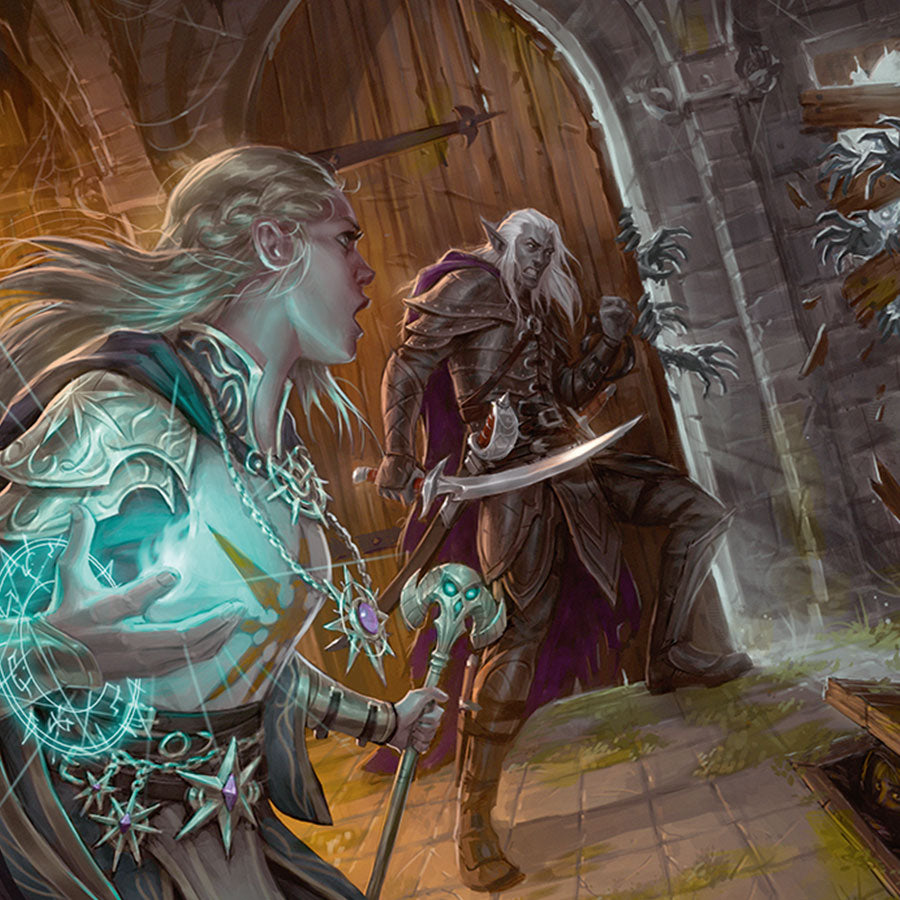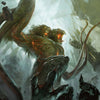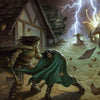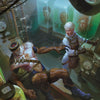How to Create and Run Complex Traps in D&D

Today in the Lair, we’re going to be discussing COMPLEX TRAPS. Most of us are familiar with simple traps – spikes poking us from the floor, falling into deep pits, and getting smoked by flaming runes. However, complex traps are used far more seldom in games, which is a shame because they can be lots of fun for players and can take your game to the next level.
Specifically, I’ll be going over what a complex trap is, how to DESIGN a complex trap, and how to RUN complex traps at your game table.
By the way, running awesome games with in-depth lore, deadly traps, and terrifying monsters doesn’t have to take hours of prep! Lairs & Legends 2 and Loot & Lore 2 have everything you need! Hand-crafted by a team of professional game masters to make it as easy to use as possible, it’s an anthology of game master resources to fuel you for years to come.
Watch or listen to this article by clicking the video below.
What is a Complex Trap?
They are not a “once and done” affair like simple traps; not just some poison needles that shoot out at you. Complex traps poise an ongoing danger and threat to the characters until it is bypassed or disabled.
Complex traps can be compared to combat with monsters. Until the monsters are dead, run away, or the characters run away, the monsters remain a threat.
That means that with complex traps everyone rolls initiative, just like you would with a combat encounter, and things are resolved in in order, round by round, just as though you were in combat rounds.
A complex trap has the following similarities with simple traps: level and threat; a trigger; and countermeasures. If you want to learn more about these elements, check out my Traps 101 article.
However, a complex trap has the following ADDITIONAL game mechanics: initiative, active elements, dynamic elements, and constant elements. We’ll get into the details of those in just a moment when we talk about designing a complex trap.
By the way, Xanathar’s Guide to Everything gives some solid information on designing and running complex traps in your game, too. So, if you want some written reference information, I suggest picking it up.
How to Design a Complex Trap
Determine the Purpose of the Trap
Why is the trap even there? Why would the creators of the trap have gone through all the effort to make such a terribly intricate trap? You should know the answer to this.
For instance, in the case of the Path of Blades trap that I’ll be using as an example here, it was placed in the entrance of a pyramid that leads to the resting place of Queen Zenobia. The trap was put there to protect the pyramid’s contents from grave robbers.
Level and Lethality
You need to determine which level the trap is designed for and how lethal it should be. Doing this pretty much the same as for simple traps, so again I’ll refer you to my Traps 101 article if you need more information on that.
I will say, though, that when determining the damage output of the trap, you need to consider how much AVERAGE DAMAGE the trap does to ALL CHARACTERS who can be expected to be affected over the course of the ENTIRE ENCOUNTER.
Which of course means you need to make some assumptions: how many PCs will probably be affected? How much damage are they likely to receive? How long is the encounter likely to last? So, doing the math for that is a bit more complicated, I admit, and based on assumptions that may or may not turn out to be accurate.
However, just remember that the CR system in 5e is mostly broken anyway, so if you don’t get it perfect, I wouldn’t sweat it too much. I mean, if monster encounters are often impossible properly balance, why shouldn’t traps be, too?
The Map
With complex traps, consider drawing out a basic map that shows where the different components of a complex trap are located: the damage-dealing parts, vulnerable elements, and anything else whose positioning might be important.
Complex traps are COMPLEX, and it’s likely during the course of the encounter that the location of different elements of the trap will become important. So, have that information figured out in advance, BEFORE your players start asking you.
For our Path of Blades trap, we have several different parts whose location is relevant: the whirling blades that slice up characters too close, pillars that can fall and crush characters in their path, and a rune of fear that affects PCs within 30 feet of it.
Active Elements
The active elements of a trap go off on certain initiative counts – usually initiative count 20 and/or 10 – and either deal damage to PCs who are in their area of effect or inflict a condition, such as being knocked prone, on them – or both inflict damage and a debilitating condition!
The active elements, then, work similarly to the way a simple traps does, except that the active elements go off EVERY ROUND.
I suggest having two to three active elements with each affecting different areas of the map. Two should deals some damage; and the third should impose a condition on PCs. Remember that dealing damage is great and all, but conditions – such as being covered in goo that slows you down – makes things more INTERESTING at the game table.
For our Path of Blades trap we have the following active elements: The whirling blades attack each creature in the first half of the hallway on initiative count 20. A crushing pillar falls on creatures in the second half of the hallway on initiative count 10.
And finally, a rune of fear that causes creatures toward the END of the hallway to become frightened and run all the way back into the first half of the hallway where they can get smoked by the whirling blades all over again.
I can see players begging for mercy already. Oh, it’s a beautiful thing!
And, of course, there are either attack rolls and saving throws for all the elements of a trap. Those will always be a thing for the various elements in a trap. You’ll use the level and threat you determined for the trap to determine what those are. And if you need help on that, I laid out some guidelines for doing that in my Traps 101 article.
Constant Elements
Constant elements represent a continual, ongoing hazard presented by the trap. These are usually one of the active elements, only instead of happening on an initiative count, it happens whenever a character ends their turn in the element’s area of effect.
For instance, with the whirling blades, not only do they do damage on initiative count 20—that’s the active element—but if a PC ends their turn within their area of effect, the PC automatically takes MORE damage from the whirling blades—that’s the constant element.
Word of wisdom here: don’t fill the map with constant effects. Let there be safe spots! That’s part of the fun for players: figuring out where it’s safe to stand and where it isn’t. This turns the challenge of the trap into not only bypassing and/or disarming it, but also learning how it works and where they can stand to take a breather and think about their next moves.
Generally speaking, too, constant elements shouldn’t do as much damage as active elements. Ending your turn in the whirling blades should be painful, but not quite as massive a wallop that happen when it’s the whirling blades’ turn in the round.
Dynamic Elements
When monsters stick with the same tactics round after round of combat – such as just squaring off and swinging away – things can get boring after a round or two. In the same way, when a complex trap only ever does the same things, it becomes predicable and less interesting for players.
Dynamic elements CHANGE over the course of the encounter with the trap, spicing things up and forcing the players to adapt to changing conditions.
Just when players think they’ve figured out where all the safe spots to stand are, the whirling blades change positions along the walls. Or, on round three, poisonous gas pours forth from holes in the floor in the SAFE SPOTS where the characters have all gathered for a breather.
Trap elements could also get more DANGEROUS as the encounter unfolds. For instance, every time the whirling blades MISS a target, they pick up speed, dealing another die of damage when they do hit. Once they hit, they slow down to their original speed, but begin picking up speed again for the next wallop.
Dynamic elements can also come into play based on the characters’ actions. If they disable the whirling blades, all of the columns tumble down, and the ceiling begins to collapse on them.
So, design at least a couple dynamic elements in your complex traps to keep things “interesting” for your players and make your traps more fun for them.
I love how we define “fun” in D&D. Monsters attacking, traps cutting you in half: yay, these things are fun! Lol
Triggers
A trigger is the thing that sets the whole trap off to begin with. It’s the oh crap moment when a player realizes they’ve done something very very bad that they’ll soon regret.
Now, what triggers a complex trap is basically the same as triggering a simple trap: pressure plates, trip wires, arcane runes, etc. If you need more information on triggers, I will once again refer you to my Traps 101 article.
Initiative
Now, I’ve already mentioned how the active elements of a complex trap will act on certain initiative counts. Now, you COULD roll for initiative for those elements, but I don’t recommend it. In the case of complex traps, it’s better to have the active elements act on set initiative counts, namely 20 and 10.
The fast elements of a trap – the whirling blades that flash out and slice PCs – should act on initiative count 20. And the slower elements of a trap – columns that tumble down to crush PCs under them – should act on initiative count 10. And, if you want to be really nasty – something I usually support – you could have super-fast elements act on BOTH initiative counts 20 and 10 in a round!
Not only is this realistic, but it also spaces the active elements out over the course of a round. And spacing an enemies’ actions out over a round makes things more interesting for players – and yes, in this case, the trap is essentially the enemy.
Countermeasures
Much like simple traps, complex traps will also have countermeasures: ways to spot them and disarm them. However, there is a big difference here: A complex trap should never be defeated with just one check!
What a terribly anticlimactic way to end all the dramatic build up! Whirling blades coming out of the walls; columns falling down on characters; a rune causing folk to run back into the whirling blades. That’s absolutely terrifying!
And then along comes the rogue, makes one die roll, disarms everything, and the group passes through the corridor with ease. Why the crap would anyone go to all the effort to creating such a complex, EXPENSIVE trap if it could be disarmed and bypassed so easily? THEY WOULDN’T! So don’t allow it.
Instead, each element of a trap should need to be disabled individually: the whirling blades, the falling columns, the rune of fear. And, the characters might need to stand in particular locations on the map in order to do so! And some elements – such as the whirling blades that stretch down half the long corridor – might need to be disabled at various points of the hallway in order to disable all of them. Thus, shutting down a particular element of a complex trap might take multiple actions and successes.
Now, you’ll determine which actions might need to be taken to disarm the various elements of the trap, but you should also allow your players to use their own creativity. They might come up with ways to disarm or bypass certain parts of the trap that would totally work, but you just didn’t think of them. That’s fine and a wonderful thing! Players coming up with unexpected solutions to problems happens all the time in the game. That’s a good thing that game masters should roll with.
How to Run a Complex Trap at the Table
After discussing how to DESIGN a complex trap, I imagine it’s fairly intuitive as to how to run it. So, I’ll keep this brief and give you the main highlights.
First, when the trap is triggered describe the beginning of some of the effects to build drama, excitement, and anticipation in your players:
“As the door slides shut behind you, you hear gears begin to rumble behind the walls; the columns lining the long hallway start to tremble ever so slightly; and you spot a faint green glow at the far end of the corridor. Everyone roll initiative!”
And then the players roll initiative and you play out the encounter much the same way you would a combat encounter. The players take their turns; the trap takes its turns; and you adjudicate and resolve things as they happen over the course of the encounter. This will, of course, include characters trying to bypass and disarm the trap, the trap dealing damage, and all the cool jazz.
Once they overcome the trap, I would definitely reward them with experience points for doing so – if you use experience points and not milestone leveling, of course – because a complex trap does represent a challenge overcome much the same as a group of monsters.
Furthermore, a complex trap should be counted against the adventuring day experience point pool. Since traps and especially complex traps are likely to deplete the characters of resources, they need to be accounted for in the total number of encounters characters will have during the “adventuring day.” And if you’re not sure how the adventuring day mechanic work, please take a look at my How to Stop Players from Resting All the Time video where I go over in detail how the adventuring day works.
It’s Time for New Legends!
Running awesome games with in-depth lore, deadly traps, and terrifying monsters doesn’t have to take hours of prep! Lairs & Legends 2 and Loot & Lore 2 have everything you need to cut your prep time in half while preserving your campaign and your story! These two massive tomes are designed to let you plug-and-play encounters, monsters, magic items, brain-burning puzzles, and more easily into your game!
Or you’ve just needed that one really cool thing for your game, but it’s just not coming to you?
Both books contain hundreds of pages of 5e game master resources, carefully crafted by a team of expert game masters to be both exciting to run and easy to use. You don’t need to parse through dense paragraphs trying to find something useful; just take a quick glance through it and you’ll have everything you need at your fingertips.
Never again feel like you’re stuck with the chore of prep so you can finally run your game: get Lairs & Legends 2 today.
-
Posted in
Game Master How-To Articles







